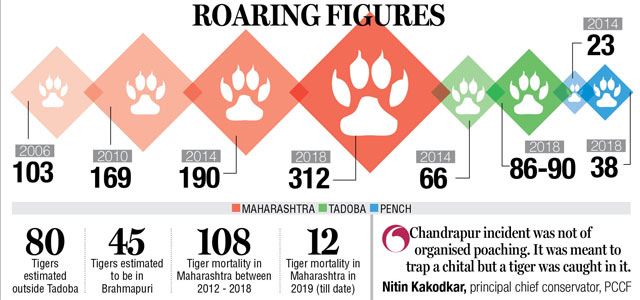
While wildlife lovers rejoice over the increase in the tiger numbers in Maharashtra from 190 in 2014 to 312 in 2018, the challenge lies in preventing man-animal conflict due to more dispersing tigers in the wild.
 Nitin Kakodkar, principal chief conservator of forests (PCCF-Wildlife), says forest managers and staff will have to keep up the vigil to prevent organised poaching, and ensure peaceful coexistence of tigers and humans. The department is also looking at conservation and translocation of tigers from congested areas to one with low carnivore numbers.
Nitin Kakodkar, principal chief conservator of forests (PCCF-Wildlife), says forest managers and staff will have to keep up the vigil to prevent organised poaching, and ensure peaceful coexistence of tigers and humans. The department is also looking at conservation and translocation of tigers from congested areas to one with low carnivore numbers.
This is because of increased levels of protection and rehabilitation of villages. It led to a rise in the prey base. Special Tiger Protection Forces (STPF) have been formed in tiger reserves. The Dr Shyamaprasad Mukherjee Jan Van Yojana has been launched to reduce the dependence of people on forests. Livelihood opportunities and toilets are being made available to people (living on the fringes of forests to reduce their dependence on jungles). Protection at the ground-level has helped and so has capacity-building of field staff.
The main challenge is that when the tiger population increases, they will start looking for new territories and this will create conflict situations with people. We will have to ensure their coexistence with people. The department will have to create awareness in people. There are challenges in protection. We cannot be complacent. Even if poaching has decreased, one has to be on watch to prevent electrocution and poisoning.
The issue of poaching is serious. Tigers were found poached at Bhandara and at Chandrapur, a tigress was caught in a wire snare near the core of the Tadoba Andhari Tiger Reserve (TATR).
The Chandrapur incident was not of organised poaching. The snare was meant to trap a chital or sambar for bushmeat but a tiger was caught in it. The poaching at Bhandara can be a bad trend as it involved a tantrik. We have to be alert to prevent organised poaching.
Staff in non-PA areas like Chandrapur and Brahmapuri have been sensitised. The staff there is as well-equipped as that in protected areas. In non-protected areas, there is interspersion between villages and forest areas, which leads to conflict. The forest staff is not entirely focussed on protection as they also have to focus on activities like tendu collection.
It is not necessary that only tiger reserves must be formed (for tiger protection and management). Tiger foundations have been created and for example, the Pench tiger foundation can fund activities in Tipeshwar. The National Tiger Conservation Authority also funds non-protected areas with tigers. There is no point having small areas like Tipeshwar and Umred Karhandla as tiger projects. Notifying new areas as PAs comes with issues like rehabilitation. At Tipeshwar, the state government rehabilitated two villages of Tipeshwar and Maregaon even though they are not tiger reserves. The state is also geared up to rehabilitate those areas which we feel are important.

This is conservation translocation. We are working on a proposal to translocate certain tigers to areas of Vidarbha, like the Navegaon Nagzira tiger reserve. We have signed MoU with Wildlife Institute of India (WII) to study the long-term dispersal of tigers and areas where they can be translocated. However there is a vast difference in the landscape and the forests in Central India and Western Ghats also differ.
The M-Stripes software is being used for monitoring in tiger reserves. We are considering setting up an e-surveillance project at Tadoba on lines of that in the Corbett tiger project.